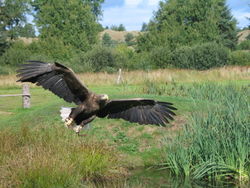White-tailed Eagle
2007 Schools Wikipedia Selection. Related subjects: Birds
| iWhite-tailed Eagle | ||||||||||||||
|---|---|---|---|---|---|---|---|---|---|---|---|---|---|---|
 Adult in flight
|
||||||||||||||
|
|
||||||||||||||
 Least Concern (LC) |
||||||||||||||
| Scientific classification | ||||||||||||||
|
||||||||||||||
|
|
||||||||||||||
| Haliaeetus albicilla (Linnaeus, 1758) |
||||||||||||||
 Light Green: nesting area
Blue: wintering area Dark Green: all-year |
The White-tailed Eagle (Haliaeetus albicilla), also known as the Sea Eagle, Erne or White-tailed Sea Eagle is a very large bird of prey in the family Accipitridae which includes other raptors such as hawks, kites and harriers.
Distribution
This is a very large eagle which breeds in northern Europe and Asia. It was successfully re-introduced to the Isle of Rum, in the Small Isles archipelago in Scotland, in 1975 and now breeds throughout the Western Isles and Small Isles as well as the islands of Mull, Skye, Lewis, Canna and the mainland coast of Wester Ross. The White-tailed Eagle is still a rare breeder in Britain following its extinction and reintroduction.
The largest population in Europe is found along the coast of Norway.
On May 22, 2006 it was announced that pair of White-tailed Eagles was breeding in a nature reserve Oostvaardersplassen in the Netherlands. This is the first time the bird has bred in the Netherlands.
White-tailed Eagles are mostly resident, only the most northerly birds move further south in winter.
Diet
The Eagle's diet is varied, including fish, birds, carrion and sometimes rodents. They regularly pirate food from otters and other birds. During the breeding season they require 500-600g of food per day when actively rearing young. During the winter months they tend to be inactive most of the day and their intake falls to 200-300g per day.
Descripition
The White-tailed Eagle is a huge bird, 76-92 cm long with a 200-250 cm wingspan. Females are significantly larger than the males. The White-tailed Eagle has broad "barn door" wings, a large head and thick "meat-cleaver" beak. The adult is mainly brown except for the paler head and neck, distinctive white tail and yellow bill and legs. In juvenile birds the tail and bill are darker, with the tail becoming white with a dark terminal band in sub-adults.
Breeding
White-tailed Eagles are sexually mature at four or five years of age. They pair for life, though if one dies replacement can occur quickly. A bond is formed when a permanent home range is chosen. They have a characteristic aerial courtship display which culminates in the pair locking claws mid-air and whirling earthwards in series of spectacular cartwheels. White-tailed Eagles are much more vocal than golden eagles, particularly during the breeding season and especially the male when near the eyrie. Calls can sometimes take on the form of a duet between the pair.
The nest of the White-tailed Eagle is a huge edifice of sticks in a tree or on a coastal cliff. Being faithful to their territories, once they breed, nests are often reused, sometimes for decades. In Scandinavia, trees have been known to collapse under the weight of enormous, long established nests.
The territory of the White-tailed Eagle ranges between 30-70 km², normally in sheltered coastal locations. Sometimes they are found in-land by lakes and along river systems. The territory of the White-tailed Eagles can overlap with the territory of the golden eagle, though competition between the two species is limited. Golden eagles prefer mountains and moorland, while the White-tailed Eagle prefers the coast and the sea.
Mated pairs produce one to three eggs per year. The eggs are laid two to five days apart in March or April and are incubated for 38 days by both parents. Once hatched, chicks are quite tolerant of one another, although the first hatched is often larger and dominant at feeding times. The female does most of the brooding and direct feeding, with the male taking over now and then. Young are able to feed themselves from five-six weeks and they fledge at eleven-twelve weeks, remaining in the vicinity of the nest, dependent on their parents for a further six-ten weeks.
Surplus chicks are sometimes removed from nests to use in reintroduction programs in areas where the species has died out.
In such programs, the birds are raised in boxes on platforms in the tree canopy and fed in such a way that they cannot see the person supplying their food, until they are old enough to fly and thus find their own food.
Heraldry
The White-tailed Eagle is believed to be the one shown in the Polish Coat of Arms.
Gallery
|
Adult (bottom) being mobbed by a Red Kite |


